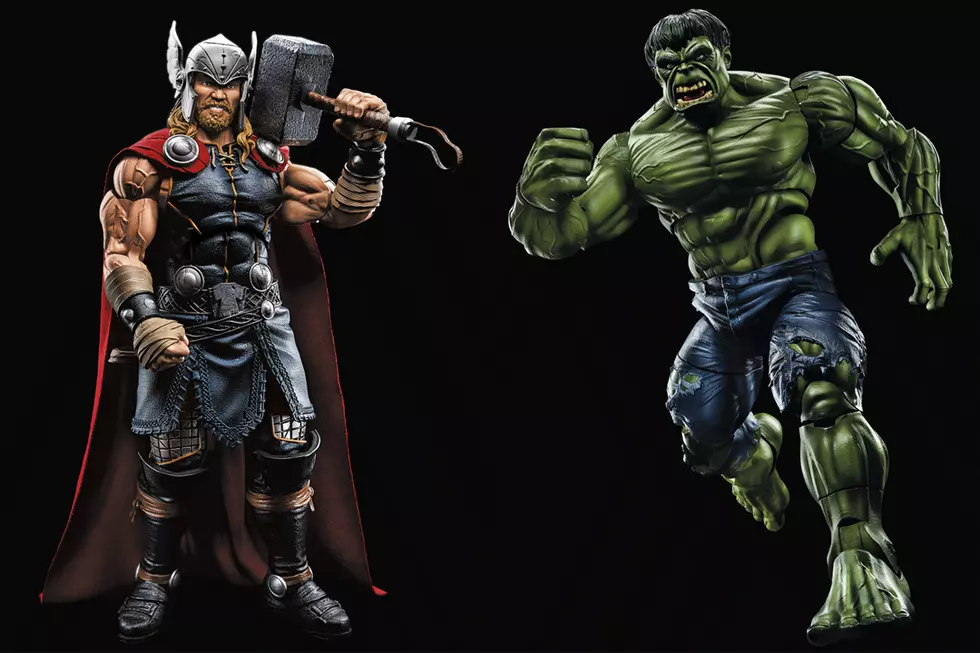
The 10 Most Awesome Moments In Walter Simonson’s ‘Thor’

This week, Marvel releases an absolutely massive omnibus that collects over a thousand pages of Walter Simonson's epic run on Thor, a book that I believe isn't just the best run on Thor, but the single greatest run on comics of all time.
That's a pretty bold statement when you consider that it's up against stuff like Alan Moore's Swamp Thing and over a hundred issues of Stan Lee and Jack Kirby on Fantastic Four, but I stand by it. In his five years as the book's writer, Simonson -- along with fellow creators Sal Buscema and John Workman -- not only defined Marvel's God of Thunder in a way that very few creators have ever managed to accomplish, he told the story of a grand adventure that combined mythology, magic and the Marvel Universe perfectly with a series of truly incredible moments.That's why today, I'm opening up my copies to bring you The Ten Most Awesome Moments From Walter Simonson's Thor! But if you haven't already gotten a copy, read at your own peril: these pages might just scratch the surface of how good that run really is, but you're definitely about to see the high points!

If nothing else, Simonson's Thor is a master class in building tension. Plot threads weave through and around each other for months, setting up and resolving with apparent ease, creating something that hooks the reader right from the start and showcases a huge cast of characters centered around not just Thor, but all of Asgard, from major players like Odin and Loki all the way down to Volstagg's kids.
And nowhere is this more evident than how the run opens:

A giant, mysterious, demonic figure slamming the heart of an exploded star onto a cosmic anvil and making a proclamation of DOOM! with a "thunder that reverberates through a billion billion worlds?" That is a hell of a way to kick off a story, especially when it introduces a plot that isn't resolved at the end of the issue. Or the next. Or the next.
Instead, Simonson plays this out for over a year -- and these were the days before the rise of the paperback market and stories that routinely took six months to finish. Even while Thor was dealing with Beta Ray Bill, Malekith and the Casket of Ancient Winters, Simonson would cut back to the scene time...

...and time again...

...so that even before Thor saw him for the first time, readers were already fully aware the Surtur the Fire Giant was going to be a huge challenge. And he was.
It's also worth noting that John Workman's distinctive lettering is absolutely incredible on these pages. The shape of the balloons and the way he arranges sound effects --- which on that first page also function as the story title and a proclamation of what's coming for Asgard -- work with the art beautifully, and are a big part of how distinctive this run ended up being.

One of the biggest changes of Simonson's run was that Thor ditched his secret identity of Dr. Don Blake, as the purpose of making Thor human to teach him humility had been fulfilled. This allowed him to go for a more full-time version of godhood that better suited the mythological storytelling Simonson brought to the table, but there were still times when Thor wanted to hang out in Midgard among humans.
To that end, Nick Fury helped him create the secret identity of construction worker Sigurd Jarlson, a disguise Thor kept up by combing his hair back and wearing a pair of glasses.
If that sounds familiar to you, just imagine how surreal it was when "Sigurd" bumped into a certain mild mannered reporter at a press conference:

Thor's completely unofficial first meeting with the Daily Planet's Clark Kent might not have had much of an impact on the story, but it's a great example of the kind of fun touches Simonson added into his work to make it such a great read.

Another big change Simonson brought in his run was the arrival of Beta Ray Bill in his first issue. He's a pretty big part of the run, and it's not just that he was an alien warrior that turned out to be an insanely powerful but likable man who was worthy of wielding Thor's hammer and his power, but because he reads like Simonson's tribute to Jack Kirby:
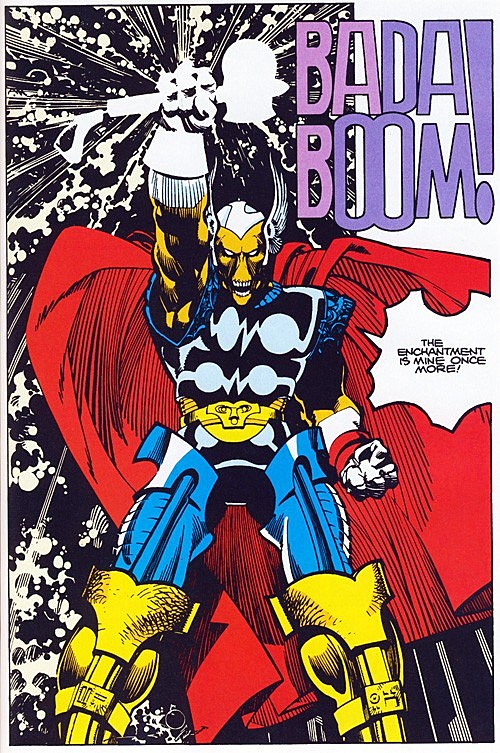
If Marvel's Thor is Norse mythology filtered through Kirby, then Beta Ray Bill is the embodiment of those Kirbyisms taken to the extreme. Not only does he have a design that boasts signatuer visual "Kirbyisms" and a name that sounds more like a member of the Forever People than someone who should be knocking around with Odin and Loki, he also takes the old Marvel Comics idea that the Asgardians were extradimensional beings worshipped as gods and goes all out with it by actually making him an alien from another dimension.
Also, the guy looks like a space horse who shows up, beats up Thor and takes his powers. There's nothing about him that should've worked at all, but he turned out to be one of Simonson's more enduring additions to the Marvel Universe, blending the high fantasy of the mythology and the sci-fi aspects that those comics were built around.

It would probably be just as easy to fill a countdown with great Loki moments from Simonson's as it is for Thor moments. Fitting his status as both Thor's arch-nemesis and his stepbrother, the God of Mischief and/or Evil (depending on who you ask) is a constant presence in the book, with schemes and machinations that sometimes take years to fully unravel.
Even so, he's a smart enough character to realize that the destruction of the Nine Worlds isn't exactly good news for him, and he joins with Thor and Odin in battle even as Surtur rampages through Asgard. In one perfect panel, Simonson sums up three characters in three two-word battle cries.
Odin fights for Asgard. Thor fights for Earth. And Loki?
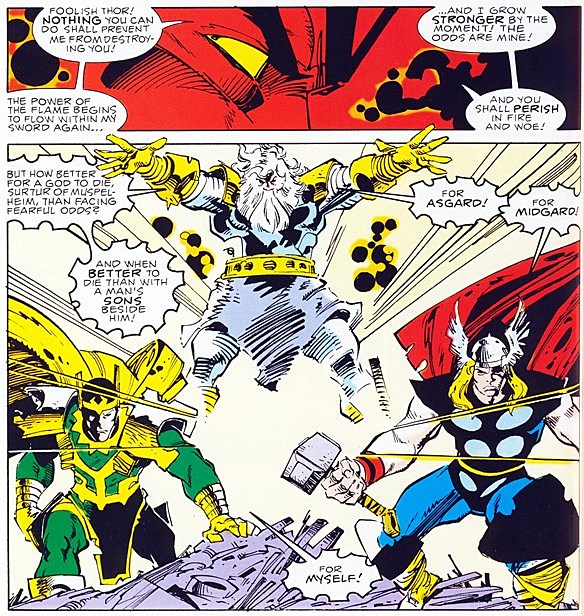
Loki fights for himself.

Another great moment for Thor and Loki came at the end of a story where Loki had worked a bit of magic to cause Thor to fall in love with Lorelei, the sister of the Enchantress, which casued no end of problems in Thor's relationship with Sif. Once he realized what was going on Thor calmly decided that a good course of action would be to crush his brother's head like a watermelon under a semi truck if he didn't remove the curse:

Playing on the idea that Mjolnir will always return to Thor's hand no matter what is a great bit of creativity that uses Thor's powers in a new way, and provides some great tension -- for Loki, if no one else.
Not to spoil it, but Loki does remove the spell and avoids having his face bashed in when Thor calmly catches the hammer in his other hand. Verily, he gotcha.

All right, one last great Loki-related moment: Thor's brief tenure as The Thunder Frog. Now, there are some fans who think of this as unforgivably silly -- as though a guy fighting a fire giant with a hammer and the help of his friend the armored space-horse -- but in many ways, Simonson's run is structured less like a super-hero comic and more like the modern version of a fable. And really, what good is a fable without an evil witch turning someone into a frog?

In this case, the witch is Loki, and the curse is even put on Thor by the kiss of a beautiful maiden -- or at least, a decent looking New York diner waitress -- and then goes into a big fairy tale story of talking frogs battling it out with sinister rats in central park and Loki creating a fake Thor to take the throne of the kingdom.
And it only gets better -- if something can truly be said to get better after detailing the time the God of Thunder had to turn down the romantic advances of the Queen of the Central Park Frogs -- once Thor recovers Mjolnir and manages to turn himself into...

...The Thunder Frog.
From there, Thor hops into a ribbiting adventure that sees him finally trouncing Loki once again and being restored to his original form. Basically, it's Little Mermaid meets Beauty and the Beast, but with more PUMMELs, THUDs and KICKs.

After writing and drawing the first 30 issues of his run, Simonson handed off art chores to Sal Buscema. Buscema's art complimented Simonson's very well, but it was still awesome to see Simonson return for Thor #380, where the two artists teamed up to bring you the battle between Thor and Jormungand, the World Serpent:
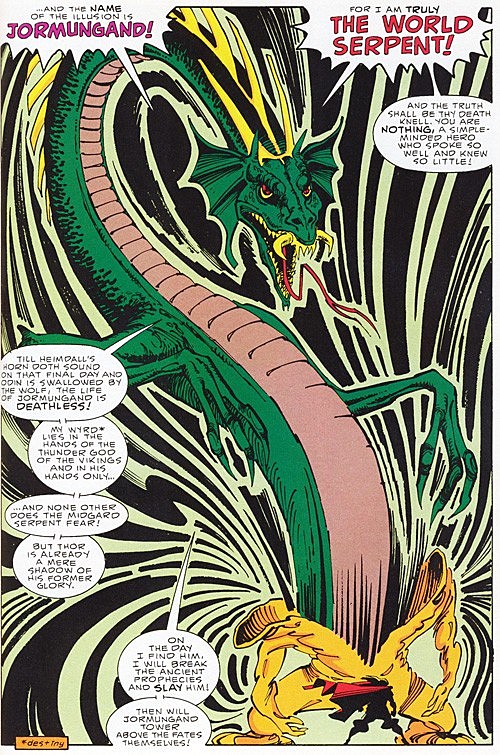
What's more, the entire issue is done in gigantic full splash pages, as Thor (weakened from prior events) and the serpent fated to kill him unleash their full power at each other in one brutal strike after another. And there's nothing quite so brutal as the scene where Jormungand finally closes its jaws around Thor...

...and Thor breaks his teeth from the inside.
I'm pretty sure that scene alone inspired at least 3 Dio albums and at least one song by Slayer. And believe it or not, that's not the hardest hit in the fight.

Like most everything in Simonson's run, Thor's battle against Hela, the Goddess of Death is one that's a long time coming. The first indications of what's going to happen comes pretty early in the run...

...but when the conflict finally hits, Thor's not quite so lucky. With two mortal souls trapped in Hel, Thor is forced to lead an army into the Realm of the Dead to battle Hela on her own terms -- which means picking a fistfight with someone who can kill you with a touch.
Even though it follows the war against Surtur in which every god of Asgard played a part and the fate of the entire Earth hung in the balance, the immeasurably smaller stakes in this battle -- two normal, mortal people -- seem huge, and it seems just as important for Thor to win. He does, of course, but not without paying a price:

Thor ends up being slashed by the hand of death herself and disfigured, leading him to grow a beard to cover up his injuries. Not exactly that much of a hassle -- except that it also leads directly to a curse that weakens him to the point of destroying his entire body before the end of the run.

Even with as much as he does for Thor himself, a huge part of what makes Simonson's run so great is what he does with the supporting cast, and one of the best examples of that is what he does with Balder.
At the start of Simonson's run, Balder, once Asgard's greatest warrior, is living a simple, completely nonviolent life, growing fat and content. Everyone sort of believes he's past his prime as a warrior, but everything changes when he's sent to deliver a message to Loki about the treacherous Malekith. The only problem is that Malekith and Loki are in cahoots, and Loki's perfectly content to let Malekith send an army of demons after him. It all comes to a head when Balder, confronted by an army of monsters, begins to literally beg them not to attack him.
And then you realize that he's not begging to save his life...
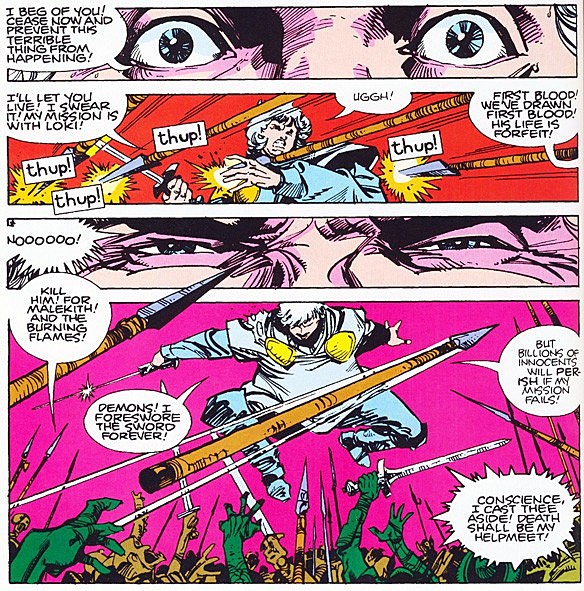
...but to save theirs.
See, like his mythological counterpart, Marvel's Balder was once killed and sent to Hel, where he was confronted with everyone he had ever killed -- and as the greatest warrior of Asgard, he killed a lot of people. And not only that, in order to return to the realm of the living, he had to kill them all again. And as he later tells Thor, when he left Hel, he didn't walk out. He swam in an ocean of blood.
Confronted with what he'd done, he swore to never take up the sword again, but charged with delivering a message that could save the entire universe, he's forced to once again.

Of course, Loki arranged the whole thing just to screw with Balder.
The underlying message of this entire run is "Loki is a massive jerk."

I've mentioned an awful lot of big moments from Simonson's Thor and I prefaced this list with a warning for spoilers -- something I don't usually do for comics over 20 years old -- but seriously: If you have not read Thor #362, then stop reading this immediately, go to the nearest comic book store, and do whatever you need to do to get a copy of it. This is not one you want to be spoiled on, because it's unquestionably one of the best moments in all of comics, period. This article'll stil be here when you get back, trust me.
If you're still here, then you know where this is going. Thor's aforementioned journey into Hel is a major turning point in Simonson's run, and for no one moreso than Skurge, the Executioner. As a recurring villain, the dimwitted Skurge was duped more often than not in to battling Thor at the command of the Enchantress, with whom he was madly in love, but when Thor puts out the call for an army to lead to Asgard, he not only joins up, but ends up playing a crucial part in the Asgardians' victory.
The problem comes when it's time to get out. With the entire nearly infinite hodes of the dead on their trail, the Asgardians come to the bridge of Gjallerbru, where Thor offers to stay behind, covering their escape by holding off the dead, sacrificing his own life in the process. And then Skurge knocks him out.

The nobility and humanity that Simonson is able to give to a character that was formerly very close to being one-dimensional is astonishing, and it leads to what still, 20 years later, ranks as one of the most stirring, moving sequences in super-hero comics. It's an unmatched feat of blending emotion, action and character that only the best comics even come close to matching.
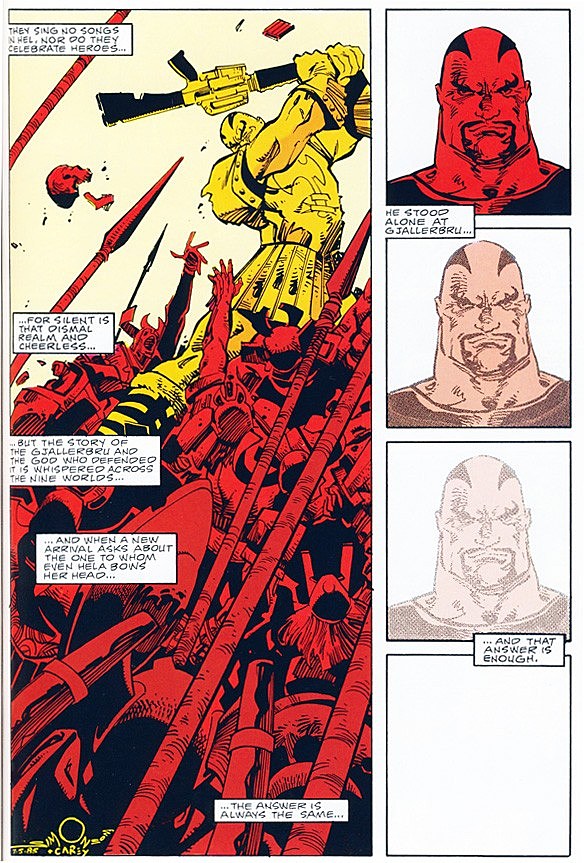
And it's an even more impressive feat considering that Simonson still managed to create a scene that emotional, that moving and that relatable, while still telling a story where someone is blowing away zombies with an M-16 in each hand.
If that's not incredible, I don't know what is.
More From ComicsAlliance
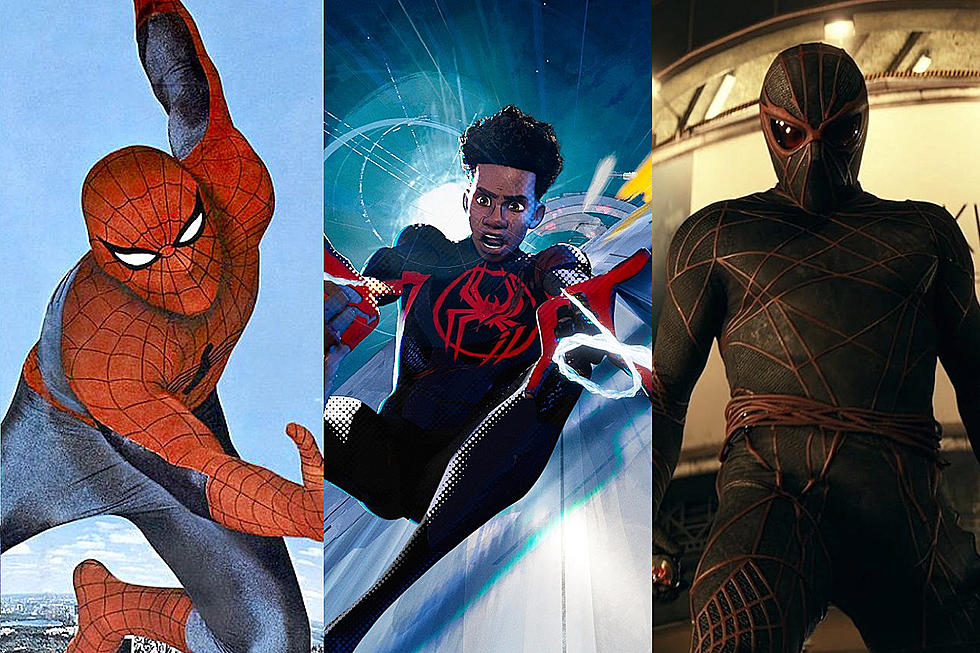
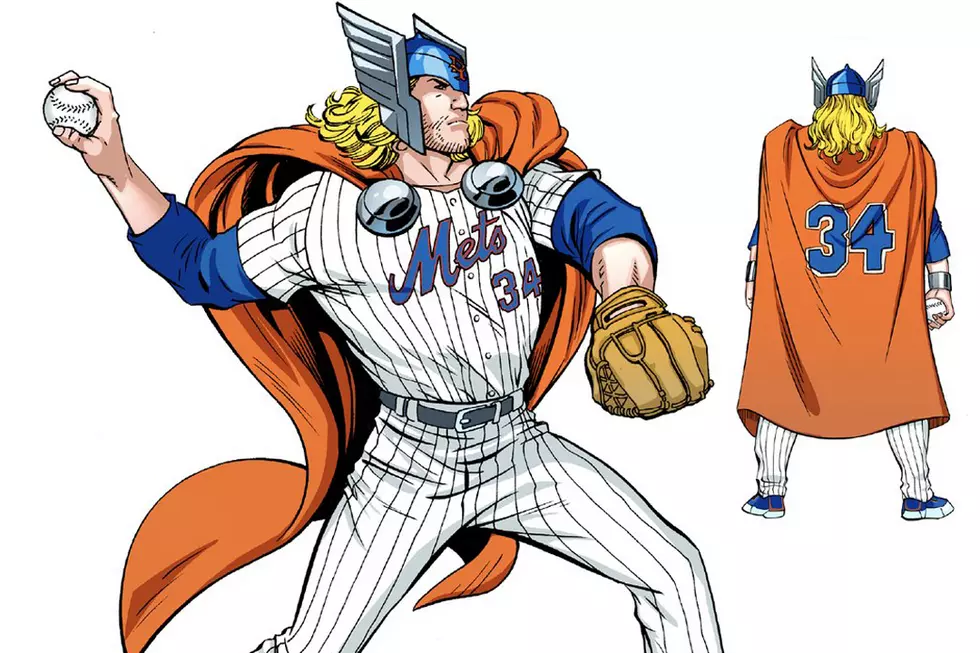
![The ‘Riverdale’ Ongoing Series May In Fact Involve A Kumite [Preview]](http://townsquare.media/site/622/files/2017/03/RD01.jpg?w=980&q=75)


![Comics’ Sexiest Female Characters (From A Queer Perspective) [Love & Sex Week]](http://townsquare.media/site/622/files/2017/02/hg_featured.jpg?w=980&q=75)

![Comics Alliance Rates The Avengers Hunks [Love & Sex Week]](http://townsquare.media/site/622/files/2017/02/marvelhunks-feat.jpg?w=980&q=75)
